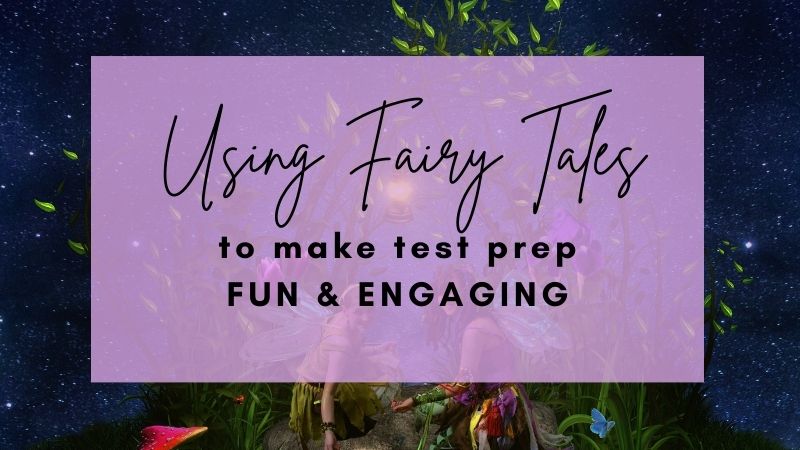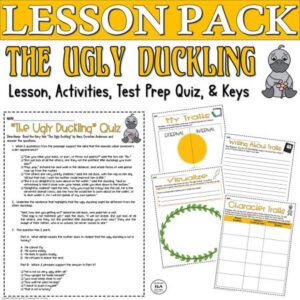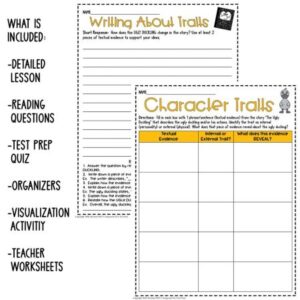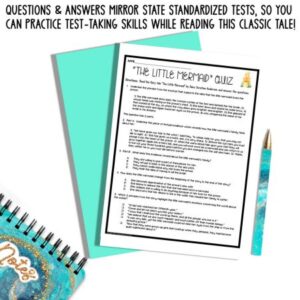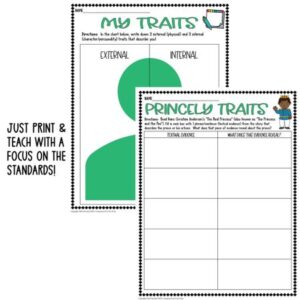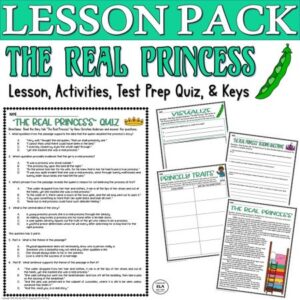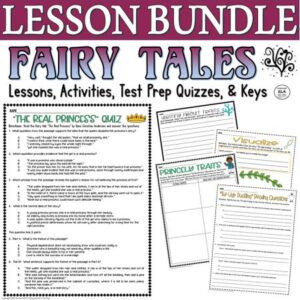Test Prep Season is officially upon us! It is the 31st of January, and we are counting down to the state reading and math standardized tests that determine the fates of students, teachers, and schools alike. Although most disdain this time of year, I really try to make the best of it even when all I want to do is teach fairy tales lessons!
And so can you. Why not integrate some fairy tales lessons into the midst of your test prep?
We can kill two birds with one stone as we integrate Fairy Tales Lessons into your Test Prep Plans!

Need help with Test Prep? Check out this FREE Pack of 3 Test Prep Activities to help students achieve success on standardized tests!
Hans Christian Andersen’s Fairy Tales Lesson Plans
I think we can all agree that Hans Christian Andersen is the Father of Fairy Tales. He has over 100 to choose from that you can use for fairy tales lessons. There are many ways we can incorporate these classic tales into our ELA classrooms even in the midst of the final days leading up to the state test!
My favorite stories to use for fairy tales lessons are “The Little Mermaid,” “The Ugly Duckling,” and “The Princess and the Pea!”
3 Ways to Integrate Test Prep into Fairy Tales Lessons
This Common Core ELA Test Prep Lesson Pack uses the Common Core standards and contains QUESTIONS and ANSWERS modeled after various state reading comprehension exams (for the story “The Ugly Duckling” by Hans Christian Andersen). This lesson would be great for 3rd, 4th, and 5th graders! One of the things I struggle with the most is preparing my students for all kinds of exams that they will encounter. With this EASY-TO-TEACH Lesson Packet, you can practice with your students, so they will feel more confident on reading tests and quizzes. It is great for pull-outs, push-ins, whole group, small group, or sub plans. Give yourself a breath of fresh air with this NO PREP curriculum that integrates test prep within the teaching of literature.

#1 Practice using Reading Strategies:
This may sound like, duh, of course, but when it comes down to it, our students need consistent practice. We can introduce them to skills through fairy tales lessons that can translate to reading effectively on the state exam.
- Check out the Title, Images, and Structure: With your students, you can pre-read a fairy tale by checking out the title, noticing how the fairy tale is formatted, and looking over any images that are provided. Then, think aloud about this information. Here are some questions you could ask about the story “The Ugly Duckling” 1) TITLES: What is the impact of the title “The Ugly Duckling?” What does it make you think about? Why do you think the author would include the word “ugly” in the title? 2) IMAGES: Why might an author add in an image of a gray bird? What colors are used in the visuals? 3) STRUCTURE: What do you notice about the first sentence of the story? Is the story long or short? What words are repeated as you skim through the passage? ***By practicing pre-reading fairy tales, your students can apply these skills to any text they encounter on a state test!
- Annotate while we read: Annotation is a skill most students are not born with. I hear many teachers tell students to annotate as they read, but most students start by randomly circling or highlighting (or drawing stick figures by the end of the story). Instead, let’s give them a focus for their annotations! Encourage students to annotate (underline, think, and write a note about a specific part) for repeated words, important characters, the setting(s), vital events, and major changes throughout the story. We can do this for ANY fairy tale we want to read. For “The Ugly Duckling,” we can focus in on repeated words like “ugly” and “pretty,” the traits of the ugly duckling before and after his transformation, the settings (beginning, middle, and end), plot elements (exposition, rising action, climax, falling action, and resolution), and any big change from start to finish! In practicing annotation with your students while you read fun and exciting fairy tales, your students will be ready to annotate and read any passage that comes their way.
- Reread, Reread, Reread: I don’t know about you, but I consistently struggle with staying focused on what I am reading. Has this ever happened to you? You begin reading a story, an article, a blog post, etc. Within a couple of minutes, you find yourself thinking about a bill you forgot to pay or a vacation you would like to take or a dream you would like to achieve. Suddenly, you realize that you have been “reading” without really READING! This happens to me all of the time, and most of my students have this problem as well! Then, because they didn’t really grasp what they read on the first try, they think they are bad readers. Oh no, they are not bad readers. They simply need to reread. I have to reread all of the time, and we need our students to realize that good readers reread for understanding. While we read our beloved fairy tales like “The Ugly Duckling,” have students reread certain parts, the parts that you know will be tough to understand, the parts that center on the theme, or the parts that make you cry either sad or happy tears. When we encourage students to reread, we empower them to reread and then truly understand any text they encounter!
#2 Use reading comprehension questions that correlate to the state exam:
This can take some time, but your students need consistent practice with the standards and question styles they will see when they take their reading comprehension exam. Let’s say we want to read “The Little Mermaid;” we can use questions linked directly to the standards that are formatted like questions on the standardized tests!

5 READING COMPREHENSION QUESTIONS FOR “The Little Mermaid”
- CITING EVIDENCE: Which phrase from the story supports the idea that the little mermaid loves the prince? Explain your reasoning.
- CHARACTERIZATION: How does the little mermaid change from the beginning of the story to the end of the story?
- CENTRAL IDEA: What is the central idea of the story? Use evidence to support your ideas.
- STRUCTURE: How does the order of events in the story affect the meaning of this quotation? “After three hundred years, thus shall we float into the kingdom of heaven,” said she.
- WORDS AND PHRASES: Read the following sentences. Which 2 words have the most similar meaning to the word “mournfully” as used in the excerpt below? “In the moonlight night, when all on board were asleep except the man at the helm, she sat on deck, gazing down through the clear water. She thought she could distinguish her father’s castle, and upon it her aged grandmother, with the silver crown on her head, looking through the rushing tide at the keel of the vessel. Then her sisters came up on the waves and gazed at her mournfully, wringing their white hands. She beckoned to them, and smiled, and wanted to tell them how happy and well off she was. But the cabin boy approached, and when her sisters dived down, he thought what he saw was only the foam of the sea.
CHECK OUT THE LITTLE MERMAID LESSON PACK THAT INCLUDES READING QUESTIONS ALREADY CREATED FOR YOU!
#3 Write with your students using a step-by-step template:
Although I work primarily with high school students, I find that writing is typically a HUGE struggle for all students. They either have no ideas or too many ideas! They don’t know how to start or end! They don’t want to disappoint their teacher who is working his or her hands to the bones to get students to write an essay, short response, or really anything.
For students who don’t start, don’t finish, or don’t achieve the goal of the writing prompt, we need to give them a step-by-step template. We can have students write about fairy tales lessons instead of boring and/or tired articles we find on the internet that we hope will prepare them for informational texts we know they will see in May. Well, if students can write analytically about fairy tales, they can write about any articles they find on a reading comprehension test.
The structure and process of writing are the same even when teaching fairy tales lessons!
Want some outdoor activity ideas to add to your fairy tales lessons? Check out Backyard Scavenger Hunt Printables: Making the Outdoors into a Classroom!
Here is a STEP-BY-STEP Guide to writing any paragraph through Fairy Tales Lessons:
Let’s say you want to read “The Princess and the Pea,” because let’s face it, who doesn’t want to read about a chick who complains about a lumpy mattress and a prince who sweeps her off her feet? I’ve had worse dates 🙂
Including reading comprehension and pre-writing activities in your fairy tales lessons will help in the writing process!
Check out this template that you can use with your students, so they too can write with confidence on any standardized test!
Here is a short response question focused on characterization and citing evidence:
How does the PRINCE change in the story “The Princess and the Pea?”
WRITING ABOUT FAIRY TALES LESSONS – SENTENCE-BY-SENTENCE STRUCTURE
1. Answer the question by referring to the beginning and ending traits of the PRINCE.
2. Write down a piece of evidence from the beginning; be sure to embed the quote.
3. Explain how the evidence links to a trait of the PRINCE at the beginning.
4. Write down a piece of evidence from the end of the story; be sure to embed the quote.
5. Explain how the evidence links to another trait of PRINCE at the end.
6. Restate how the PRINCE changes by the end of the story.
With these simple steps, you can integrate test prep into the fairy tales lessons you love without having to sacrifice quality. Fairy Tales Lessons are completely captivating, full of relatable messages, and even the most reluctant student!
Want all 3 fairy tales lessons? Click below!
Check out my store at Integrated ELA Test Prep in order to make your life easier with fairy tales lessons your students will LOVE as you prepare them for any standardized test!
This blog post was written by Kristin Menke, The Integrated Teacher.

